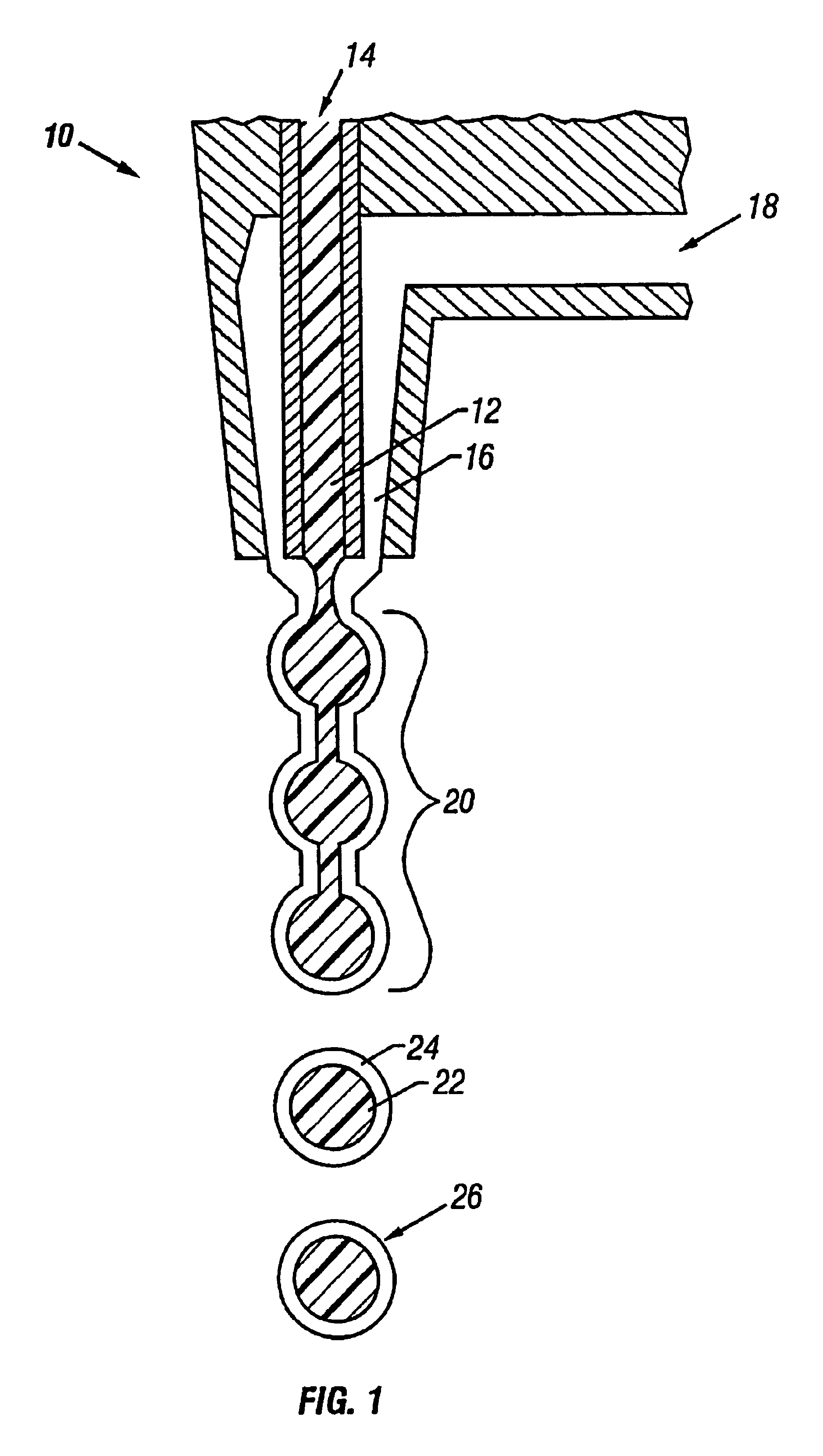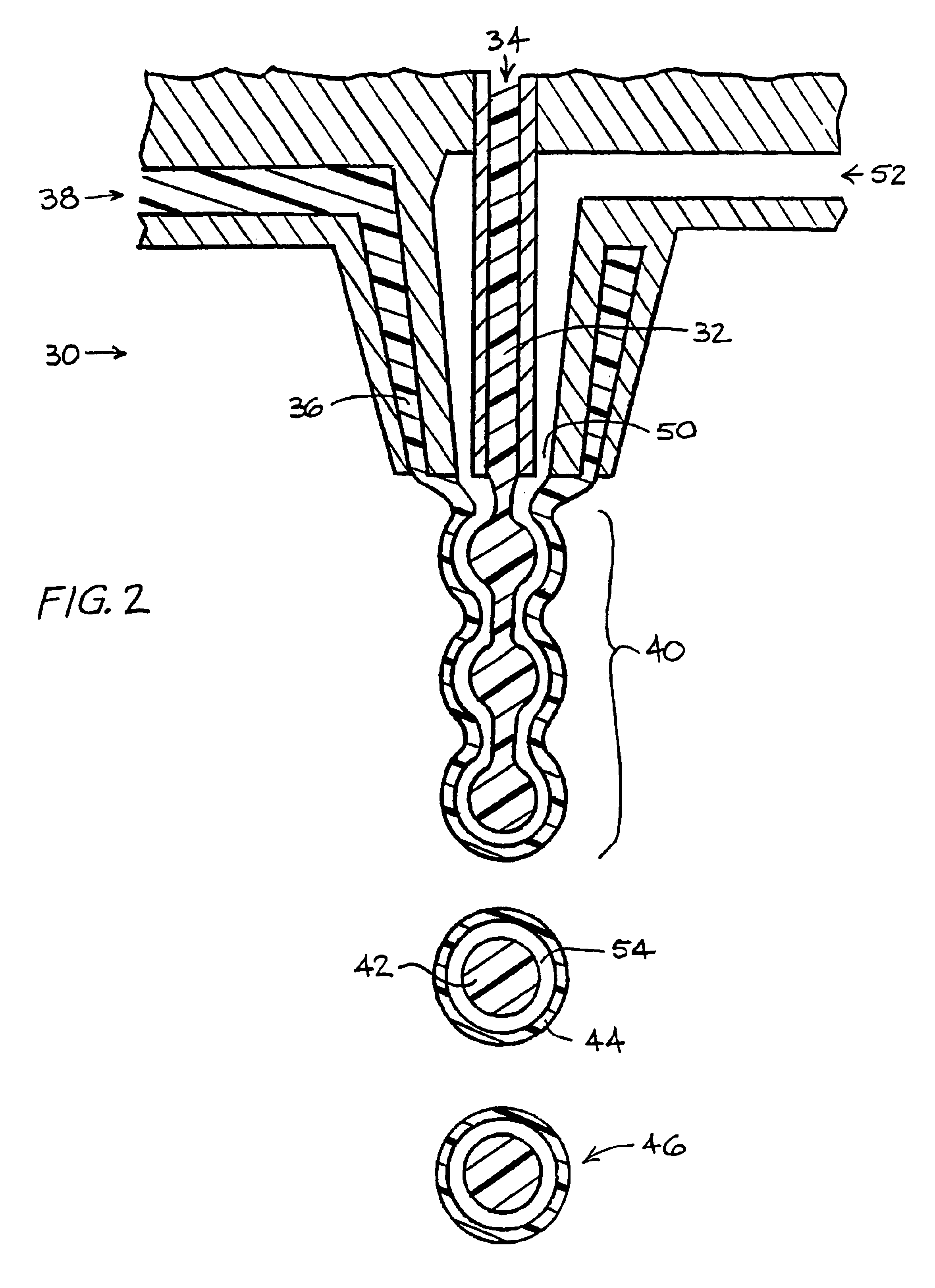Microencapsulated and macroencapsulated drag reducing agents
- Summary
- Abstract
- Description
- Claims
- Application Information
AI Technical Summary
Benefits of technology
Problems solved by technology
Method used
Image
Examples
example 1
In this Example, a vibrating nozzle technique would be used. The nozzle center bore 12 would have a diameter of 125 μm, where the annulus 16 would have an inner diameter of 130 μm and an outer diameter of 250 μm. The nozzle 10 would vibrate back and forth at a frequency of about 700 Hz to about 1000 Hz.
The core material 14 would be a mixture of alpha-olefins to give a copolymer of polyalpha-olefins as the core 22. A Ziegler-Natta catalyst, in combination with suitable activators, would be added to the core material 14 just prior to its extrusion into the nozzle 10. The Ziegler-Natta catalyst to be used would be TiCl3.AA that is available as a powder from Akzo Chemical Inc., Chicago, Ill. Diethylaluminum chloride (DEAC) and diethylaluminum ethoxide (DEALE) would serve as the preferred activators and are available in the hydrocarbon soluble liquid form from Akzo Chemical. The Ziegler-Natta catalyst would be slurried in a hydrocarbon solvent like kerosene, along with the activators tha...
example 2
This Example would illustrate the microencapsulation of preformed polymer DRA present in a slurry made by a controlled precipitation process. This portion of the Example is similar to that of Example 12 of U.S. Pat. No. 5,733,953, incorporated by reference herein.
The precipitation portion of the inventive process would be carried out in a Ross double planetary mixer. One hundred parts by weight of a 10% solution of FLO 1012 in isopentane would be charged to the mixer. In a separate vessel, 2 parts of magnesium stearate would be slurried in 100 parts of isopropyl alcohol. The magnesium stearate / alcohol slurry would be added in slowly to the copolymer solution with agitation over a two hour period. This procedure would produce a finely divided polyolefin precipitate that would be essentially a dispersion of very fine polymer DRA particles (100 μm to 150 μm) in isopropyl alcohol and isopentane. After precipitation, the concentration of polymer in the slurry would be about 5 wt. %. The ...
example 3
This example would illustrate the microencapsulation of preformed polymer DRA present in a slurry made by a controlled precipitation process. This portion of the example is from Example 12 of U.S. Pat. No. 5,733,953, incorporated by reference herein.
The precipitation portion of the inventive process was carried out in a Ross double planetary mixer. One hundred parts by weight of a 10% solution of FLO 1020 in Isopentane was charged to the mixer. In a separate vessel, 2 parts of magnesium stearate was slurried in 100 parts of isopropyl alcohol. The magnesium stearate / alcohol slurry was added in slowly to the copolymer solution with agitation over a two hour period. This procedure produced a finely divided polyolefin precipitate that is essentially a dispersion of very fine polymer DRA particles (100 μm-150 μm) in isopropyl alcohol and isopentane. After precipitation, the concentration of polymer in the slurry is about 5 wt %. The isopentane which is the polymerization solvent can be r...
PUM
| Property | Measurement | Unit |
|---|---|---|
| Length | aaaaa | aaaaa |
| Electrical resistance | aaaaa | aaaaa |
| Molecular weight | aaaaa | aaaaa |
Abstract
Description
Claims
Application Information
 Login to View More
Login to View More - R&D
- Intellectual Property
- Life Sciences
- Materials
- Tech Scout
- Unparalleled Data Quality
- Higher Quality Content
- 60% Fewer Hallucinations
Browse by: Latest US Patents, China's latest patents, Technical Efficacy Thesaurus, Application Domain, Technology Topic, Popular Technical Reports.
© 2025 PatSnap. All rights reserved.Legal|Privacy policy|Modern Slavery Act Transparency Statement|Sitemap|About US| Contact US: help@patsnap.com


